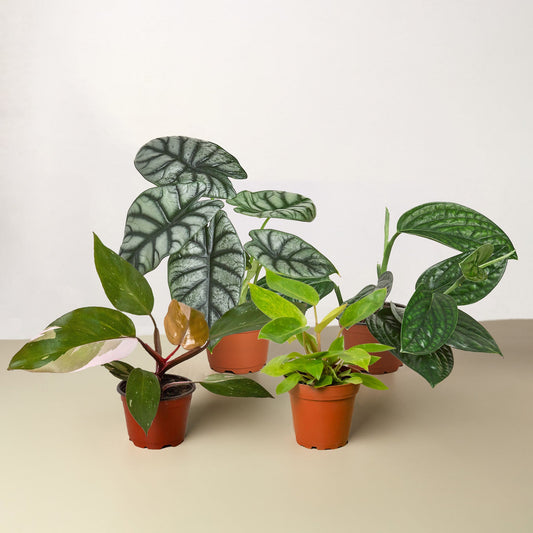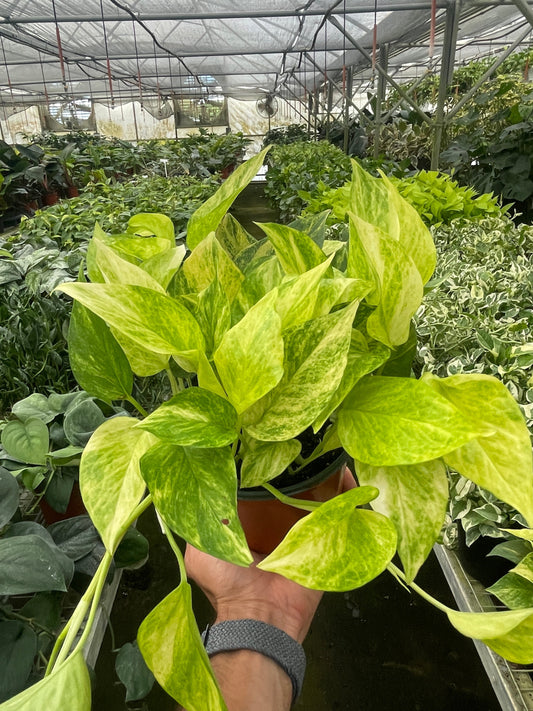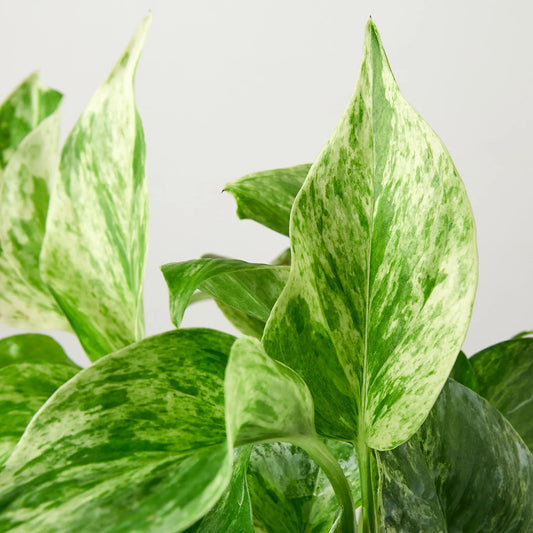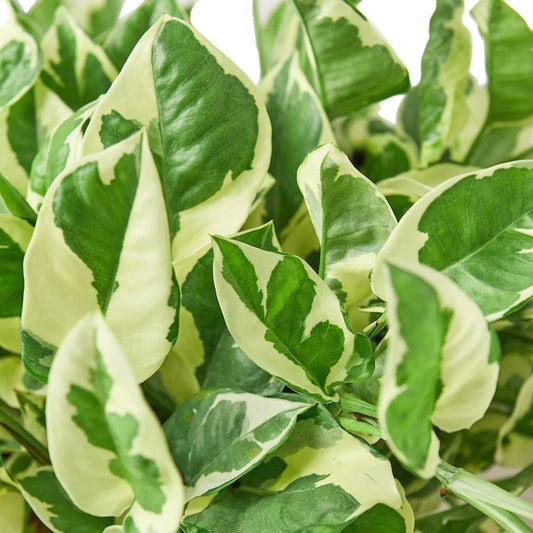Philodendron Melanochrysum Aerial Roots: Everything You Need to Know
Cafe Planta Team
Philodendron Melanochrysum might sound like a mouthful, but this stunning plant is a favorite among plant lovers. Known for its velvety, dark green leaves and striking golden veins, it adds a touch of elegance to any indoor space. One fascinating feature of this plant is its aerial roots, which can be both a blessing and a bit of a mystery for those new to its care.
In this article, we'll talk about everything you need to know about Philodendron Melanochrysum's aerial roots. From understanding what they are and why they're important, to tips on how to care for them and use them to your advantage, we'll cover it all. Whether you're a seasoned plant parent or just getting started, there’s something here for everyone.
What Are Aerial Roots?
Aerial roots are those curious little tendrils you see sprouting from the nodes of your Philodendron Melanochrysum. Unlike the roots you find buried in soil, aerial roots grow above ground. They have a variety of functions, which can vary depending on the plant species, but they typically help with structural support, moisture absorption, and nutrient intake.
In the wild, Philodendron Melanochrysum uses these roots to attach itself to trees as it climbs toward the light. At home, these roots can be encouraged to climb a moss pole or trellis, which mimics their natural habitat. This not only helps the plant grow healthier but also adds a beautiful vertical element to your plant display.
These roots are an adaptation that allows the plant to thrive in its native environment. They can absorb moisture and nutrients from the air, which is a handy skill when you’re living high up in a tree canopy! For indoor gardeners, this means aerial roots can help your plant stay hydrated and nourished, even if its soil is a bit on the dry side.
Why Are Aerial Roots Important?
Understanding the role of aerial roots can help you make informed decisions about how to care for your Philodendron Melanochrysum. These roots play a critical part in the plant's overall health and stability. Let's break down why they're important:
- Support: As your plant grows taller, it needs the extra support that aerial roots provide. This is especially important if you’re training your Philodendron to climb.
- Nutrient and Moisture Absorption: Aerial roots can absorb nutrients and moisture from the air, which is particularly useful if you’re growing your plant in less-than-ideal soil conditions.
- Propagation: Aerial roots can also be used to propagate your plant. When you take a cutting from a node with aerial roots, it can help the cutting establish itself more quickly in its new environment.
While they might look a bit wild and untamed, aerial roots are a sign of a healthy and thriving Philodendron Melanochrysum. They’re doing what they’re meant to do, and with a little care and attention, they can help your plant look its absolute best.
How to Care for Aerial Roots
Now that you know why aerial roots are important, let's talk about how to care for them. The good news is that these roots are relatively low-maintenance, but there are a few things you can do to encourage healthy growth:
- Humidity: Aerial roots thrive in humid environments, so consider placing your Philodendron in a room with a humidity level of at least 60%. A pebble tray or a room humidifier can help increase humidity if needed.
- Support Structures: Provide a moss pole or trellis for your plant to climb. This not only helps the aerial roots anchor themselves but also promotes vertical growth.
- Misting: Occasionally mist the aerial roots to provide extra moisture, especially if your home is on the dry side.
- Pruning: Trim back any aerial roots that become too unruly or if they’re not attaching to the support structure as you’d like.
By following these simple care tips, you can ensure that your Philodendron Melanochrysum’s aerial roots remain healthy and functional, helping your plant thrive.
Training Your Philodendron to Climb
If you've ever seen a Philodendron Melanochrysum climbing up a moss pole, you know how stunning it can look. Training your plant to climb not only showcases its beauty but also mimics its natural growing conditions, promoting healthier growth.
Start by choosing a sturdy moss pole or trellis that’s at least as tall as the plant. Insert the pole into the pot, making sure it’s stable and won’t topple over. Gently tie the main stem of your Philodendron to the pole using soft plant ties or twine, being careful not to damage the stem or leaves.
As the plant grows, continue to tie the stem to the support structure, allowing the aerial roots to grip onto the moss pole. This encourages the plant to climb and can lead to larger, more vibrant leaves. Plus, it adds a striking vertical element that's sure to draw attention in any room.
Remember, patience is key. It may take some time for the plant to fully attach and start climbing, but with consistent care and gentle guidance, your Philodendron Melanochrysum can become the centerpiece of your plant collection.
Using Aerial Roots for Propagation
One of the joys of plant parenting is propagating your beloved plants, and Philodendron Melanochrysum is no exception. Aerial roots play a significant role in the propagation process, as they can help new cuttings establish themselves more quickly.
To propagate using aerial roots, first, identify a healthy section of the plant with at least one node and a few aerial roots. Using a clean, sharp knife or scissors, cut below the node, ensuring you have a good length of stem for planting.
Place the cutting in water or directly into soil. If propagating in water, change the water regularly to keep it fresh. Once roots have developed, usually within a few weeks, you can transfer the cutting to soil. If you’re planting directly into soil, keep the cutting moist and in a humid environment until it establishes new growth.
Thanks to the aerial roots, the cutting should root more easily and quickly, giving you a new plant to enjoy or share with friends!
Dealing with Unruly Aerial Roots
Aerial roots can sometimes become a bit unruly, sprawling in all directions and threatening to take over your space. While they’re a natural part of the plant’s growth, there are ways to manage them if they start to get out of hand.
- Prune: If the roots are becoming too long or unsightly, feel free to trim them back. Use clean, sharp scissors to make a clean cut, which will minimize the risk of infection.
- Train: Encourage the roots to attach to a moss pole or other support structure. This can prevent them from sprawling and gives your plant a more compact appearance.
- Hide: If you’re not a fan of the look of aerial roots, you can gently tuck them into the soil or wrap them around the base of the plant. Just be careful not to damage the roots when doing so.
Managing aerial roots is a personal choice, and it largely depends on your aesthetic preferences. Some people love the wild, jungle-like appearance they give, while others prefer a more controlled look. Both are perfectly valid choices!
Common Mistakes with Aerial Roots
As with any aspect of plant care, there are a few common mistakes that people make when dealing with aerial roots. Fortunately, they're easy to avoid with a bit of knowledge:
- Ignoring Humidity: Aerial roots need a humid environment to thrive. If your home is too dry, the roots can become brittle and less effective at absorbing moisture.
- Overwatering: While aerial roots can absorb moisture, overwatering the plant itself can lead to root rot. Make sure the soil is well-draining and only water when the top inch is dry.
- Neglecting Support: Without a support structure, aerial roots can become unruly and may not provide the stability the plant needs. A moss pole or trellis is a great investment.
By avoiding these mistakes, you can ensure that your Philodendron Melanochrysum remains healthy and visually appealing, with aerial roots that contribute to its overall well-being.
Enhancing Interior Design with Philodendron Melanochrysum
Beyond its botanical beauty, Philodendron Melanochrysum can be a fantastic addition to your home’s interior design. Its vertical growth habit and striking foliage make it an excellent choice for adding height and drama to a room.
Consider placing your plant in a corner where it can climb a trellis, creating a natural focal point. The plant’s dark green leaves can provide a beautiful contrast against light or neutral walls, adding depth and texture to your space.
For a more cohesive look, try pairing your Philodendron with other plants that have similar care needs. Grouping plants together can create a lush, indoor jungle vibe that's both stylish and soothing. Plus, having multiple plants can help increase the overall humidity in the area, benefiting the aerial roots.
With a little creativity, your Philodendron Melanochrysum can become more than just a plant—it can be a central element in your home’s design scheme, bringing life and nature into your living space.
Final Thoughts
Philodendron Melanochrysum's aerial roots are a unique and fascinating feature that offer both aesthetic and functional benefits. From providing structural support to aiding in propagation, these roots are an integral part of the plant’s health and beauty. Caring for them is straightforward and can make a significant difference in how your plant grows and thrives.
At Cafe Planta, we're dedicated to helping you with all your plant care needs. If you have any questions or need advice, don't hesitate to reach out via email or connect with us on Instagram. We believe in the power of plants to connect and inspire, and we're here to support you on your plant journey!



















